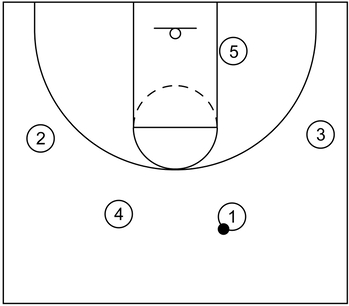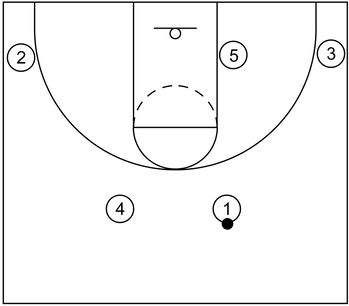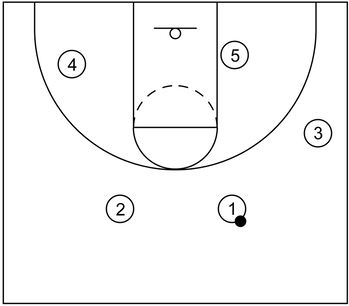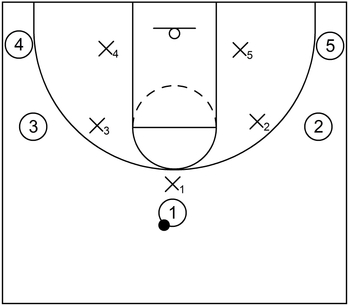What is a period within the game of basketball
A period comprises a certain amount of time, commonly measured in minutes, that occurs within at least one segment of an entire basketball game.
What are the main types of basketball time periods
Quarter
A quarter is a type of period that splits the total amount of minutes within a game of basketball into four evenly divided segments.
What’s more, following the end of the first and third quarters, there is usually a small intermission period that lasts approximately one to three minutes before the basketball game continues to the second or fourth quarter respectively.
Furthermore, it should be noted that the quarter is generally the most common type of time period utilized within organized competition.
The quarter time period is typically implemented within various basketball leagues, which includes youth basketball, middle school competition (also known as junior high school), high school competition, NCAA women’s basketball, the NBA, the WNBA, various FIBA leagues, and many other competitive leagues in between.
In addition to that, the quarter time length generally varies depending on the basketball league of competition.
At the youth basketball level, quarters will generally last about six to eight minutes with some leagues also implementing a running clock as well.
At the middle school or junior high level, some leagues could implement six-minute quarters while other leagues might set seven-minute quarters.
A few leagues may even employ eight-minute quarters or ten-minute quarters with a running clock.
At the high school level, the varsity teams commonly play eight-minute quarters while the junior varsity and 9th grade teams could play quarters ranging from six minutes to eight minutes, depending on the league.
In NCAA women’s college basketball, the WNBA, and FIBA, the length of each quarter is ten minutes while in the NBA, the length of each quarter is twelve minutes.
Related: RULE NO. 5: Scoring and Timing – NBA Official
Related: Basic Basketball Rules – FIBA
Related: Basketball – NFHS
Half
A half is a type of period that splits the total amount of minutes within a game of basketball into two evenly divided segments.
Basketball games that utilize the half time period do not include the brief intermission like the quarter time period.
Instead, basketball games that execute this time model simply use the longer intermission period known as halftime, which is also common within most (if not all) forms of organized competition.
Additionally, as it relates to organized play, this type of time period is mainly implemented within NCAA men’s college basketball and the time length is twenty minutes per half.
Halftime
Halftime is a special type of intermission period that occurs, as the name implies, at the half time of a basketball game.
So, if a game of basketball utilizes the quarter time model, which consists of four total quarters, then the halftime intermission period would occur immediately after the end of the second quarter.
On the other hand, if a basketball game implements the half period type, which consists of two total halves, then the halftime would happen right after the end of the first half.
Also, at the high school level and possibly other lower levels of organized competition, halftime typically lasts for about ten minutes.
Nonetheless, it could also increase to a maximum of fifteen minutes for certain types of events or activities as long as the home team has given proper notice to the visiting team before the start of the basketball game.
Conversely though, at higher levels of competition such as NCAA basketball, NBA, WNBA, and FIBA, the duration of halftime is generally fifteen minutes altogether.
Overtime
Overtime is a extended type of period that occurs after the finalization of the standard or regulation time frames of quarters or halves when the score is tied between the two opposing teams.
Essentially, the two opposing teams will play, as the name implies, over the time of the original total minutes within the basketball game.
At the high school level, the overtime period typically lasts for a total of four minutes or at least half of a regulation quarter for non-varsity matches, which could also potentially apply to youth basketball or middle school competition as well.
At higher competition levels such as the NCAA, NBA, WNBA, and FIBA, overtime generally lasts for a total of five minutes.
At the end of the overtime period, if one of the two teams has more points than their opposition, then that team with the higher amount of points will be declared the winner of the game.
However, if at the end of the overtime period, the score is still tied between the two teams, then another overtime period would be played and this overtime sequence would typically continue until one of the two teams scores more points than their opponent.
What generally occurs on the court between teams during a basketball period
Creation of scoring opportunities via offensive action
A team that is in possession of the basketball during a period generally seeks to create opportunities to score points via various systems, strategies, or tactics of basketball offense.
The following diagram example below attempts to illustrate this point.
It is a basic play from a 1-4 low formation that could be executed during a period within a basketball game and it shows at least two potential scoring opportunities for an offensive team.
Moreover, on the diagram, the offensive players are represented by the standard basketball positions.
That is to say, 1 is the point guard, 2 is the shooting guard, 3 is the small forward, 4 is the power forward, and 5 is the center.
Basic offensive play with at least two scoring options

To begin the action, 1 dribbles toward the basket via the on-ball screen set by 5. After the screening action, 5 rolls to the basket while 4 cuts toward the top near the open space, which is also known as roll and replace action.
Following that, 5 could receive the ball from 1 and then score at the rim with a layup or dunk. On the other hand, 4 could receive the ball from 1 and take the three-point jump shot if open.
Alternatively, 1 could also keep possession of the ball, take the mid-range jump shot, or attack the rim and score by way of a layup or floater in the lane.
Restriction or prevention of scoring opportunities via defensive execution
A team that is not in possession of the basketball during a period generally attempts to restrict or prevent the opposing team’s scoring opportunities via different systems, strategies, or tactics of basketball defense.
The following diagram example below attempts to illustrate this point.
It is a defensive strategy known as a zone defense, and more specifically, a 2-3 zone defense, that primarily focuses on influencing contested jump shots, limiting dribble penetration, and restricting scoring opportunities for the offensive team, especially from the low post areas.
Furthermore, on the diagram, the defensive players would be represented by standard basketball positions, similar to the offensive players of the previous diagram.
That is to say, X1 is the defensive point guard, X2 is the defensive shooting guard, X3 is the defensive small forward, X4 is the defensive power forward, and X5 is the defensive center.
Basic zone defense implemented to restrict offensive scoring opportunities

To start the offensive action, 3 receives the ball from 1. However, when that happens within a basketball period, the zone defenders will shift to certain areas of the court in an attempt to limit the opposing team’s scoring opportunities.
X1 slides toward the right side wing area just inside of the three-point arc while X2 slides over toward the center of the free throw line, which is also known as the nail area.
From that point, X1 basically dares 3 to take a jump shot, which X1 could easily contest with a hand near the face of 3.
In addition to that, X2 prevents or heavily restricts dribble penetration towards the middle area of the court.
In other words, if 3 is able to blow by X1 with some type of dribble move towards the middle, then X2 will automatically be able to provide help defense by standing near the nail spot, which also limits an opportunity for 3 to drive towards the basket.
In terms of the back side of the zone, X3 remains at their current position, X4 slides toward the basket, particularly near the left side of the lane line, and X5 slides over to defend against 5, who is near the right side low post area.
As a result of those actions on the back side, X3 is ready to provide help if 3 tries to dribble towards the baseline area.
Moreover, if 5 receives the ball from 3, then X3 could dig at the ball in an attempt to steal it without fouling.
Alternatively X3 could execute a double team with X5 to influence 5 to throw a kick pass to another teammate near one of the perimeter areas of the court.
X4 is in position to hinder or totally prevent a basketball cut, particularly a dive cut, towards the rim by 2 or 4, who are currently located on the weak side of the court.
What offensive strategies could be potentially implemented during a basketball period
These are examples of various offensive strategies that could be potentially implemented during a period of time within a basketball game.
1-4 high offense

The 1-4 high offense is a basketball offensive strategy that primarily utilizes the high posts as well as the wing areas to create scoring opportunities near the basket or near the perimeter areas of the court, typically with a variety of basketball cuts and/or basketball screens.
The 1-4 high offense could be beneficial, especially for undersized basketball teams because two offensive players are initially stationed near the high post areas.
This, in turn, influences two defenders, particularly low post defenders, to play away from the basket. From there, the offensive team could take advantage of that with certain offensive actions such as backdoor cuts.
1-4 low offense

The 1-4 low offense, sometimes referred to as 1-4 flat, is a basketball offensive strategy that features one offensive player at the top beyond the three-point line and four additional players adjacent to the baseline, specifically near the low post blocks and corners areas on the left side and right side of the court.
The 1-4 low offense could be beneficial for teams that prefer to play through their guards and/or teams that like to utilize basketball screens, especially the on-ball screen or different types of basketball cuts.
2 out 3 in motion offense

The 2 out 3 in motion offense is a basketball offensive strategy that emphasizes ball movement, split cuts, and continuity patterns to create scoring opportunities near the basket or from the perimeter.
The 2 out 3 in motion offense could be useful for teams that desire to generate potential three-point jump shots as well as low post scoring opportunities.
3 out 2 in motion offense

The 3 out 2 in motion offense is a basketball offensive strategy that seeks to create multiple scoring opportunities through the use of set plays as well as offensive actions such as basketball screens, basketball cuts, continuity patterns and pick and roll options among others.
The 3 out 2 in motion offense could be potentially beneficial for teams who possess two highly skilled post players with scoring capabilities, particularly near the basket.
4 out 1 in motion offense

The 4 out 1 in motion offense seeks to create a wide variety of scoring opportunity via the use of two players within the slots, two players near the wings or corners, and one player near the high or low post area.
The 4 out 1 in motion offense could be favorable for teams who are able to execute the foundational skills of passing, dribbling, cutting, screening, and shooting.
5 out motion offense

The 5 out motion offense seeks to create scoring opportunities, especially near the basket via the use of five offensive players located within five perimeter spots on the court.
The 5 out motion offense could be beneficial for teams that do not necessarily possess one or two dominant scorers because it is a team-based offense.
In essence, all players can actively contribute and become viable scoring options when executing the 5 out motion offense.
Box offense

The box offense is a basketball offensive strategy that utilizes quick hitting set plays to create scoring opportunities near the basket or near the perimeter, particularly for the team’s best players.
The box offense is generally versatile and could therefore be useful for perimeter-oriented teams, post-oriented teams, or teams that contain a mixture of both types of players.
Flex offense

The flex offense is a basketball offensive strategy that creates scoring opportunities near the basket or near the perimeter within a period of time, typically by way of two types of basketball screens known as the flex screen and the down screen.
The flex offense is also generally positionless so all five players could have an equal opportunity to score through the use of close-range shots or via jump shots, especially from three-point range.
Hawk offense

The Hawk offense is a unique basketball offensive strategy that utilizes high post action, a stack alignment, and various basketball screens to create scoring opportunities near the basket or near perimeter areas of the court.
The Hawk offense can be executed by teams who desire to create scoring opportunities for their best shooters or it could be utilized by teams that prefer to play through their best low post players.
Horns offense

The Horns offense is a basketball offensive strategy that emphasizes spacing to create scoring opportunities near the basket or near the perimeter by way of various actions such as basketball screens and dribble handoffs.
The Horns offense could be advantageous because it opens up the low post areas, which also influences defenders away from those areas as well.
Princeton offense

The Princeton offense is a basketball offensive strategy that features three unique series of actions known as Chin, Low and Point to create scoring opportunities near the basket or from the perimeter.
The Princeton offense is generally most favorable for teams that are able to utilize the fundamental skills of cutting, dribbling, passing, screening, and shooting.
Shuffle offense

The shuffle offense is a basketball offensive strategy that utilizes the shuffle cut, certain types of basketball screens, and a possible continuity pattern to create scoring opportunities near the basket or near perimeter areas of the court.
The shuffle offense could be beneficial for teams that do not necessarily possess one or more dominant scorers as each of the five players will have a possible opportunity to score at some point during offensive execution.
Stack offense

The stack offense is a basketball offensive strategy that features one player at the top and four additional players stacked together in two pairs on either side of the post areas.
The stack offense could be implemented during a time period by teams who are looking to generate scoring opportunities for the point guard, the wing players, and/or the post players.
Triangle offense

The triangle offense is a basketball offensive strategy that primarily consists of three players forming a sideline triangle on one side of the court to create scoring opportunities via the use of various actions such as ball movement, basketball cuts, and basketball screens, mainly based on the reactions of the defense.
The triangle offense includes innate flexibility and is could be utilized by teams with at least one dominant scorer or by teams with no dominant scorers.
In essence, any of the offensive players would have a potential opportunity to score points by way of close-range shots or via open jump shots within the flow of the triangle offense.
UCLA offense

The UCLA offense is a basketball offensive strategy that emphasizes the UCLA screen and UCLA cut to create various scoring opportunities, primarily near the basket but also near the perimeter areas of the court as well.
The UCLA offense is versatile in that it features scoring options from the high post area, which could be beneficial for undersized or guard-oriented teams as well as high low scoring options, which could be useful for teams that prefer to play through their low post players.
What defensive strategies could be potentially implemented during a basketball period
These are examples of different defensive strategies that could be potentially implemented during a period of time within a basketball game.
1-1-3 zone defense

The 1-1-3 zone defense is a basketball defensive strategy that seeks to prevent low post scoring opportunities while influencing contested field goal attempts and limiting dribble penetration with on-ball pressure, particularly near the top or wings.
1-2-1-1 press defense

The 1-2-1-1 press defense, also known as the diamond press, is a basketball defensive strategy that features full court pressure and sideline traps, particularly in the backcourt, which could lead to limited scoring opportunities as well as possible turnovers for the offensive team.
One particular advantage of the 1-2-1-1 press defense is that it could be beneficial for teams that have speed, quickness, great conditioning, but less than ideal individual offensive skill sets.
1-2-2 press defense

The 1-2-2 press defense is a basketball defensive strategy that features moderate defensive pressure and sideline traps, particularly in the backcourt or frontcourt, which in turn, could limit offensive scoring opportunities.
Essentially, the 1-2-2 press defense is typically a containment-type press that has the general emphasis to disrupt the rhythm and flow of the offensive team and force them to execute several passes as they attempt to break the press.
1-3-1 zone defense

The 1-3-1 zone defense is a basketball defensive strategy that seeks to disrupt offensive scoring opportunities by influencing contested jump shots and limiting dribble penetration, while executing solid on-ball defense.
One noteworthy benefit of the 1-3-1 zone defense is that the defender at the top executes defensive pressure against the player in possession of the ball.
When this occurs, the pressure could potentially cause the ball handler to play faster than usual, which in turn could lead to offensive disruption and eventual turnovers.
2-2-1 press defense

The 2-2-1 press defense is a basketball defensive strategy that seeks to limit offensive scoring opportunities with the possibility of creating turnovers by way of sideline traps in the backcourt or frontcourt.
2-3 zone defense

The 2-3 zone defense is a basketball defensive strategy that seeks to limit dribble penetration, influence contested perimeter jump shots, and decrease offensive scoring opportunities, particularly from the low post areas, while executing adequate on-ball defense.
Box and 1 defense

The box and 1 defense is a basketball defensive strategy and a junk defense which seeks to limit scoring opportunities, especially for the opposing team’s best perimeter player, by implementing a combination of man to man and zone defense principles.
In essence, the main objective of the box and 1 defense is for the defensive team to utilize their best defender to disrupt or neutralize the scoring and/or playmaking abilities of the offensive team’s best perimeter player, particularly with man to man defensive pressure.
What’s more, at the same time, the additional four defenders will play zone defense in the form of a box, hence the name of box and 1.
Man to man defense

Man to man defense is a type of basketball defensive system that emphasizes each defender guarding a certain offensive player, typically based on their respective basketball positions, to ultimately limit or prevent scoring opportunities near the basket or near the perimeter areas of the court.
One notable advantage of man to man defense is that it could be potentially useful against offensive players with inadequate dribbling skills and/or offensive teams that prefer to score from the perimeter areas of the court, particularly with three-point jump shots.